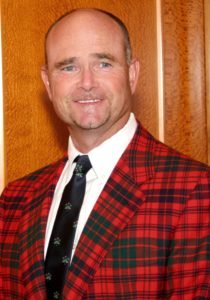 Brian Curley, a principal with Scottsdale, Arizona-based Schmidt-Curley Design, Inc., was raised in Pebble Beach, California, where he played, caddied and worked at area courses developing an appreciation of the game and its architecture. He began his career with Landmark Golf Company as a land planner and eventually focused largely on course design and construction, working later with Ron Fream on an extensive list of international projects. Schmidt-Curley has combined with twelve golfing legends to create Mission Hills, the world’s largest golf resort, outside Hong Kong. Some of his other projects include California courses such as the Crosby National Golf Club in Rancho Santa Fe, the Faldo Course at Shadow Ridge in Palm Desert, and Talega in San Clemente. He also designed Royal Oaks Country Club in Houston, Texas; the Las Vegas Paiute Resort; Royal Dunes in Phoenix, Arizona; and Vidbynas in Stockholm, Sweden.
Brian Curley, a principal with Scottsdale, Arizona-based Schmidt-Curley Design, Inc., was raised in Pebble Beach, California, where he played, caddied and worked at area courses developing an appreciation of the game and its architecture. He began his career with Landmark Golf Company as a land planner and eventually focused largely on course design and construction, working later with Ron Fream on an extensive list of international projects. Schmidt-Curley has combined with twelve golfing legends to create Mission Hills, the world’s largest golf resort, outside Hong Kong. Some of his other projects include California courses such as the Crosby National Golf Club in Rancho Santa Fe, the Faldo Course at Shadow Ridge in Palm Desert, and Talega in San Clemente. He also designed Royal Oaks Country Club in Houston, Texas; the Las Vegas Paiute Resort; Royal Dunes in Phoenix, Arizona; and Vidbynas in Stockholm, Sweden.
I have been going to Asia once a month for twelve years, so my travel experiences have been varied, especially within mainland China. The main lesson I’ve learned is that when it comes to travel, you have zero control over some things, so there is no sense in getting upset. The key is to fly first class or business whenever possible – not so much for the seat but for the lounge and preferential treatment when there is an issue; the waits can extend for hours and hours.
I can’t say I’ve had a “difficult” client, but we have certainly worked for some inexperienced developers: those who didn’t know a par-three from a par-four or -five. I would hate to see what could have happened to them with a poorly qualified architect and no checks and balances.
Our company has probably worked with more PGA Tour players as golf course design consultants than any other – the list is long. The input of those players varies from none to slight with the occasional decent input. Although the input is often small, I never forget the notion that it is their name on the golf course and I need to honor their wishes and those of the client. Once the design process starts however, it keeps going. I tell the players and design consultants that we are like the bus driver: you can choose to get on or off, but the bus keeps moving!
I owe my career to my parents, especially my dad for moving the family to Pebble Beach when I was young. I may never have gotten into the business if my dad hadn’t been a golfer himself. He taught me the game and, since he was very gregarious, showed me how to deal with people.
From the age of twelve, I knew I wanted a career in golf. I was a decent player but far from a threat to join the Tour, especially with the talented juniors around the area, including Bobby Clampett. Every golf professional I knew complained about his or her job, so I ruled out being a club professional. Very little if any attention was paid to the golf architect, even on the most highly regarded courses. Cypress Point, for instance, was never referred to as an Alister Mackenzie design – it was simply Cypress Point. The architect of Pebble Beach was similarly anonymous.
One day, while working as a cart boy at Spyglass Hill, I noticed that the course was designed by a guy named Robert Trent Jones. If he could make a living at it, so could I, I thought. The artistic end came naturally to me, as I could always draw, although Pete Dye later told me that the most important thing to be able to draw is a paycheck!
There is no question that both my partner Lee Schmidt and I consider Pete Dye our mentor. I was extremely fortunate to cut my teeth with Pete during a period of time when he was doing some of his most influential designs. Part genius and part knucklehead, he could not only come up with crazy ideas but convince a client to buy into them. Nobody in this business comes close to Pete in combining quality work and a unique personality. Nobody ever will.
There is no doubt that the architect’s role is much more art than science, and becoming more so all the time. As the world of communication grows, imaging of courses becomes more prevalent and accessible. There was a time when a course’s reputation was strictly through word of mouth or a photo or two shown to the privileged few. Now photos are easily obtained, shared, and promoted. Even the most private facility can be accessed by Google Earth. The result, in a world of instant gratification, is that a golf course gets judged largely on looks. This, in turn, places greater demand on a course to look good now, not years down the road. The architect, in turn, must keep pace with the visuals as well as the long list of other elements of design and construction.

